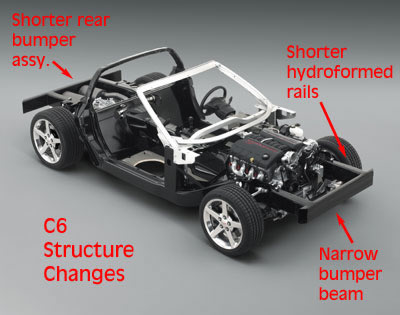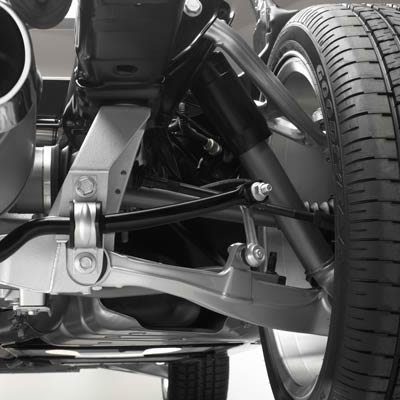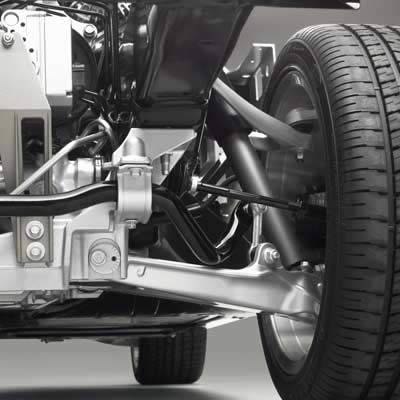C6, Naked and Exposed: Corvette Action Center's First Look at the 2005 Corvette - Page 5 of 6
 |
 |
C6, Naked and Exposed: Corvette Action Center's First Look at the 2005 Corvette - Page 5 of 6
by Hib Halverson
©2004 Corvette Action Center
No use without permission
Chassis, Suspension and Brakes
The Sixth-Generation Corvette chassis retains key characteristics of the ground-breaking 1997 model: front engine, rear transaxle, low-mass and high stiffness in bending and torsion. Backbone structure, hydroformed steel frame rails, closed steel driveline tunnel, steel bulkhead behind the seats, balsa-wood-cored composite floors and aluminum cockpit structure, all pioneered in C5 continue in enhanced form for C6.
To reduce the length of the car, 2.4-inches were taken off the front of the hydroformed rails and the fore/aft width of the front bumper beam was thinned by 0.63-in. In the rear, shortening was accomplished by more efficient placement of the energy absorbing foam used to enhance the car's crashworthiness, shortening the rear bumper structure and the redesign of the rear fascia. In addition to dimensional changes, in the interest of increased stiffness and weight reduction, the C6 structure was also upgraded by 1) a materials change in the tunnel "close-out panel" from steel to aluminum, 2) a reinforced instrument panel, cross-car beam and 3) the addition of composite reinforcements to the rear compartment tub and aluminum braces under the tub.
The result of all this was a five-inch reduction in length, two inches off the front and three off the rear. It is noteworthy that the shortening and a 1.1-in decrease in width makes the '05 virtually the same size as one of its prime competitors in the high-sports market, the Porsche 911. In the mass department, the two are close, too, with the base, C6's curb weight of 3179 lbs and the base Porsche 911 Carrera targa's 3119 lbs. within 2% of each other.
The 2005 suspension, while similar in configuration to that of '97-'04, is all-new. No major parts carry over. There are: new front and rear suspension cradles, new front and rear control arms, new front and rear knuckles, new steering rack, new tie rods, new springs, new stabilizer bars, new shocks, new wheels, new tires and a lot of other new small pieces. The suspension redesign was driven by: 1) a goal of improved ride and handling, 2) a goal of improved steering and 3) a 1.2-in. increase in wheelbase required by a longer, five-speed automatic transmission in the other car built off the GM245 platform, the Cadillac XLR.
Improved ride is accomplished by: 1) increasing suspension travel, 0.5-in. in the front (.15-in. compression and .35-in. rebound) and 0.8-in at the rear (all rebound), 2) revised shock valving which takes advantage of the increased travel and 3) softer, more compliant Goodyear EMT (run-flat) tires.
How the first two work is pretty obvious. You increase the travel and the suspension has farther to go before it tags the bump stops. Then, you revise your shock valving to take advantage of the increased travel. At the rear, increased travel forced revisions to the knuckle and relocation of the rear spring from below to above the lower control arms. Because of the wheelbase change, both the rear suspension cradle and the rear control arms had to be redesigned.
The story of the third generation, Goodyear "Extended Mobility Tire" is an article in itself. Goodyear's long-time engineer for Corvette, Larry Jansen, assisted by Jansen's new replacement, Nick Hill, worked with the Corvette Team's ride-and-handling engineers, led by Mike Neal, in developing a new approach to run-flat tires.
C5's EMTs had to provide a level of handling which made the car safe to drive on flat tires. With a revised, low tire-pressure warning system, which communicates with both the driver and the car's standard dynamic chassis control systems, the C6 relies partially on Active Handling, which goes into a more aggressive, safety-oriented mode when low or no tire pressure is detected, for safe handling on flat tires.The first two generations of Goodyear run-flats, the GS-C EMT of 1994 and the F1 GS EMT of 1997, had very stiff casings because, once deflated, stiffness was necessary for safe handling. With C6, because the tires are no longer required to provide 100% of the handling necessary for safe, run-flat operation, the third generation EMT tire casings could be softened in some areas and significantly softened in one specific area. The result is a run-flat which rides better, is quieter and improves handling when the car is driven near the limit on tires inflated to the proper pressures. The new Goodyear F1 GS-2 EMT's on the front of C6es (P245/40ZR18) are the same width as those on C5 but are on an inch-larger wheel. The tires on the rear (P285/35ZR19) are a bit wider and, also, mount on inch-larger wheels.
Responding to one of the C5 owner community's biggest complaints: interior road noise; the '05 Corvette not only has quieter tires but also has better acoustic insulation in the rear of the car. Our 12/18/03 preview did not include an opportunity to drive a C6, so we'll reserve judgment on noise level until we road test one, but if what GM told us (variously describing the decrease in noise as "huge" or even, as one engineer told us, "humongous") is to be believed, C6 owners will enjoy a higher level of refinement in a reduction of road noise.
With C6's steering, the goal was to reduce C5's slight tendency towards trough-wander. This is can be a problem on some old or poorly-constructed asphalt roads which carry a lot of heavy truck traffic. The trucks' weight eventually causes slight depressions or "troughs" where their tires run. If a car trough-wanders, its tires tend to "climb" the sides of the troughs. The driver feels this as a "pulling" right or left along with a change in steering effort. Many people blame this on brakes because they most often feel it when slowing down to stop on a troughed road and braking amplifies the problem.
"Trough wander can be greatly reduced by increasing caster," Mike Neal told the Corvette Action Center, "so we increased caster in the front, but it's not as simple as just bumping up the caster (adjustment). We had to change where the front lower control arm mounts on the front suspension cradle, so the cradle is new, too. The control arm is slightly different. The knuckle is different. Adding caster changes ride steer, or toe change with ride travel, so we had to reposition the steering rack. The other thing that helped us with trough wander is the improvement in run-flat tire technology."
In meeting the goal of reduced trough wander, Neal told us that front tie rod loads went up so calibration changes were made to the power assist valving which affect the steering rack's effort curve. He went on to say that, at the time we interviewed him on 12/30/03, there was still minor handling and steering tuning work to be completed prior to the C6's start of production early this summer. Lastly, on steering, as it was with C5, ordering the Z51 option gets you a power steering cooler. |
 |


